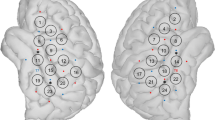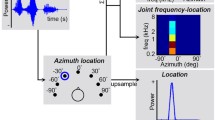Abstract
Inter-individual differences in loudness sensation of 45 young normal-hearing participants were employed to investigate how and at what stage of the auditory pathway perceived loudness, the perceptual correlate of sound intensity, is transformed into neural activation. Loudness sensation was assessed by categorical loudness scaling, a psychoacoustical scaling procedure, whereas neural activation in the auditory cortex, inferior colliculi, and medial geniculate bodies was investigated with functional magnetic resonance imaging (fMRI). We observed an almost linear increase of perceived loudness and percent signal change from baseline (PSC) in all examined stages of the upper auditory pathway. Across individuals, the slope of the underlying growth function for perceived loudness was significantly correlated with the slope of the growth function for the PSC in the auditory cortex, but not in subcortical structures. In conclusion, the fMRI correlate of neural activity in the auditory cortex as measured by the blood oxygen level-dependent effect appears to be more a linear reflection of subjective loudness sensation rather than a display of physical sound pressure level, as measured using a sound-level meter.





Similar content being viewed by others
References
Algom D, Marks LE (1990) Range and regression, loudness scales, and loudness processing: toward a context-bound psychophysics. J Exp Psychol Hum Percept Perform 16:706–727
Bilecen D, Seifritz E, Radu EW, Schmid N, Wetzel S, Probst R, Scheffler K (2000) Cortical reorganization after acute unilateral hearing loss traced by fMRI. Neurology 54:765–767
Bilecen D, Seifritz E, Scheffler K, Henning J, Schulte AC (2002) Amplitopicity of the human auditory cortex: an fMRI study. NeuroImage 17:710–718
Brechmann A, Baumgart F, Scheich H (2002) Sound-level-dependent representation of frequency modulations in human auditory cortex: a low-noise fMRI study. J Neurophysiol 87:423–433
Brett M, Anton JL, Valabregue R, Poline JB (2002a) Region of interest analysis using an SPM toolbox. In: 8th International Conference on Functional Mapping of the Human Brain (Sendai, Japan). Neuroimage 16(2): abstract 497
Brett M, Johnsrude IS, Owen AM (2002b) The problem of functional localization in the human brain. Nature Reviews Neurosci 3:243–249
Edmister WB, Talavage TM, Ledden PJ, Weisskoff RM (1999) Improved auditory cortex imaging using clustered volume acquisitions. Hum Brain Mapp 7:89–97
Epstein M, Florentine M (2009) Binaural loudness summation for speech and tones presented via earphones and loudspeakers. Ear and Hearing 30:234–237
Ernst SMA, Verhey JL, Uppenkamp S (2008) Spatial dissociation of changes of level and signal-to-noise ratio in auditory cortex for tones in noise. NeuroImage 43:321–328
Ernst SMA, Uppenkamp S, Verhey JL (2010) Cortical representation of release from auditory masking. NeuroImage 49:835–842
Fletcher H, Munson WM (1933) Loudness, its definition, measurement and calculation. J Acoust Soc Am 5:82–108
Gabriel B, Kollmeier B, Mellert V (1997) Influence of individual listener, measurement room and choice of test-tone levels on the shape of equal-loudness level contours. Acta Acustica united with Acustica 83:670–683
Genovese CR, Noll DC, Eddy WF (1997) Estimating test–retest reliability in functional MR imaging. 1: Statistical methodology. Magn Reson Med 38:497–507
Glover GH, Li TQ, Ress D (2000) Image-based method for retrospective correction of physiological motion effects in fMRI: RETROICOR. Magn Reson Med 44:162–167
Griffiths TD, Uppenkamp S, Johnsrude I, Josephs O, Patterson RD (2001) Encoding of the temporal regularity of sound in the human brainstem. Nat Neurosci 4:633–637
Grimm G, Hohmann V, Verhey JL (2002) Loudness of fluctuating sounds. Acta Acustica united with Acustica 88:359–368
Guimaraes AR, Melcher JR, Baker JR, Ledden P, Rosen BR, Kiang NYS, Fullerton BC, Weisskoff RM (1998) Imaging subcortical auditory activity in humans. Hum Brain Mapp 6:33–41
Gutschalk A, Patterson RD, Rupp A, Uppenkamp S, Scherg M (2002) Sustained magnetic fields reveal separate sites for sound level and temporal regularity in human auditory cortex. NeuroImage 15:207–216
Hall DA, Haggard MP, Akeroyd MA, Palmer AR, Summerfield AQ, Elliott MR, Gurney EM, Bowtell RW (1999) “Sparse” temporal sampling in auditory fMRI. Hum Brain Mapp 7:213–223
Hall DA, Haggard MP, Summerfield AQ, Akeroyd MA, Palmer AR, Bowtell RW (2001) Functional magnetic resonance imaging measurements of sound-level encoding in the absence of background scanner noise. J Acoust Soc Am 109:1559–1570
Hart HC, Palmer AR, Hall DA (2002) Heschl’s gyrus is more sensitive to tone level than non-primary auditory cortex. Hear Res 171:177–190
Hart HC, Hall DA, Palmer AR (2003) The sound-level-dependent growth in the extent of fMRI activation in Heschl’s gyrus is different for low- and high-frequency tones. Hear Res 179:104–112
Harvey AK, Pattinson KT, Brooks JCW, Mayhew SD, Jenkinson M, Wise RG (2008) Brainstem functional magnetic resonance imaging: disentangling signal from physiological noise. J Magn Reson Imaging 28:1337–1344
Hegerl U, Gallinat J, Mrowinski D (1994) Intensity dependence of auditory evoked dipole source activity. Int J Psychophysiol 17:1–13
Heller O (1985) Hörfeldaudiometrie mit dem Verfahren der Kategorienunterteilung. Psychologische Beiträge 27:478–493
Jäncke L, Shah NJ, Posse S, Grosse-Ryuken M, Müller-Gärtner HW (1998) Intensity coding of auditory stimuli: an fMRI study. Neuropsychologia 36:875–883
Jäncke L, Mirzazade S, Shah NJ (1999) Attention modulates activity in the primary and the secondary auditory cortex: a functional magnetic resonance imaging study in human subjects. Neurosci Lett 266:125–128
Juckel G, Schmidt LG, Rommelspacher H, Hegerl U (1995) The tridimensional personality questionnaire and the intensity dependence of auditory evoked dipole source activity. Biol Psychiatry 37:311–317
Juckel G, Hegerl U, Giegling I, Mavrogiorgou P, Wutzler A, Schuhmacher C, Uhl I, Brüne M, Mulert C, Pogarell O, Rujescu D (2008) Association of 5-HT1B receptor polymorphisms with the loudness dependence of auditory evoked potentials in a community-based sample of healthy volunteers. Am J Med Genet Part B, Neuropsychiatric Genetics 147B:454–458
Kriegeskorte N, Simmons WK, Bellgowan PSF, Baker CI (2009) Circular analysis in systems neuroscience: the dangers of double dipping. Nat Neurosci 12:535–540
Langers DRM, van Dijk P, Backes WH (2005) Lateralization, connectivity and plasticity in the human central auditory system. NeuroImage 28:490–499
Langers DRM, van Dijk P, Schoemaker ES, Backes WH (2007) fMRI activation in relation to sound intensity and loudness. NeuroImage 35:709–718
Lasota KJ, Ulmer JL, Firszt JB, Biswal BB, Daniels DL, Prost RW (2003) Intensity-dependent activation of the primary auditory cortex in functional magnetic resonance imaging. J Comput Assist Tomogr 27:213–218
Logothetis NK, Wandell BA (2004) Interpreting the BOLD signal. Ann Rev Physiol 66:735–769
Menzel D, Fastl H, Graf R, Hellbrück J (2008) Influence of vehicle color on loudness judgments. J Acoust Soc Am 123:2477–2479
Mohr CM, King WM, Freeman AJ, Briggs RW, Leonard CM (1999) Influence of speech stimuli intensity on the activation of auditory cortex investigated with functional magnetic resonance imaging. J Acoust Soc Am 105:2738–2745
Mulert C, Jäger L, Propp S, Karch S, Störmann S, Pogarell O, Möller HJ, Juckel G, Hegerl U (2005) Sound level dependence of the primary auditory cortex: simultaneous measurement with 61-channel EEG and fMRI. NeuroImage 28:49–58
Pascoe DP (1978) An approach to hearing aid selection. Hearing Instruments 29:12–16
Quirk GJ, Armony JL, LeDoux JE (1997) Fear conditioning enhances different temporal components of tone-evoked spike trains in auditory cortex and lateral amygdala. Neuron 19:613–624
Röhl M, Uppenkamp S (2010) An auditory fMRI correlate of impulsivity. Psychiatry Res Neuroim 181:145–150
Röhl M, Kollmeier B, Uppenkamp S (2011) Spectral loudness summation takes place in the primary auditory cortex. Hum Brain Mapp 32:1483–1496
Schneider P, Sluming V, Roberts N, Scherg M, Goebel R, Specht HJ, Dosch HG, Bleeck S, Stippich C, Rupp A (2005) Structural and functional asymmetry of lateral Heschl’s gyrus reflects pitch perception preference. Nat Neurosci 8:1241–1247
Sigalovsky IS, Melcher JR (2006) Effects of sound level on fMRI activation in human brainstem, thalamic and cortical centers. Hear Res 215:67–76
Stephens SD (1970) Personality and the slope of loudness function. Q J Exp Psychol 22:9–13
Thirion B, Pinel P, Meriaux S, Roche A, Dehaene S, Poline JB (2007) Analysis of a large fMRI cohort: statistical and methodological issues for group analyses. NeuroImage 35:105–120
Verhey JL, Uhlemann M (2008) Spectral loudness summation for sequences of short noise bursts. J Acoust Soc Am 123:925–934
von Kriegstein K, Patterson RD, Griffiths TD (2008) Task-dependent modulation of medial geniculate body is behaviorally relevant for speech recognition. Curr Biol 18:1855–1859
Yang Y, Engelien A, Engelien W, Xu S, Stern E, Silbersweig DA (2000) A silent event-related functional MRI technique for brain activation studies without interference of scanner acoustic noise. Magn Reson Med 43:185–190
Zhang CY, Zeng FG (1997) Loudness of dynamic stimuli in acoustic and electric hearing. J Acoust Soc Am 102:2925–2934
Acknowledgments
This study was supported by grants from Deutsche Forschungsgemeinschaft (Up 10/2-2, GRK-591/3). The authors would like to thank all volunteers for participating in this study. The helpful comments and suggestions by the reviewers and by J. Melcher as the associate editor are gratefully acknowledged.
Author information
Authors and Affiliations
Corresponding author
Rights and permissions
About this article
Cite this article
Röhl, M., Uppenkamp, S. Neural Coding of Sound Intensity and Loudness in the Human Auditory System. JARO 13, 369–379 (2012). https://doi.org/10.1007/s10162-012-0315-6
Received:
Accepted:
Published:
Issue Date:
DOI: https://doi.org/10.1007/s10162-012-0315-6




